
PREV ARTICLE
NEXT ARTICLE
FULL ISSUE
PREV FULL ISSUE
THE ELUSIVE UNTOUCHED ROMAN BRONZE COINS
An article by Geoffrey Cope published June 17, 2015 on CoinWeek f\dsicsses the difficulty of finding high-condition, uncleaned and
untouched Roman bronze coins. -Editor

it is hard to find authentic coins in a state of preservation that really means a ‘natural’ bronze Roman coin. (Just washed to take away the earth or mud or clay) With Gold or Silver it is far easier – here we only need to be careful about whether the coin is genuine. Over the last 50 years as I remember Gold and Silver were plentiful in the trays at Leu Numismatics in Switzerland. Bronze choice pieces were always in a small box in the back office tucked away. Although these bronzes coins were struck in vast quantities and used by the ‘plebeian of the Roman Empire’ by the millions they were the most difficult coins to find in wonderful condition. These Bronze coins could not be enjoyed by everybody as quality pieces in a wonderful state of preservation were always very rare. This story of availability was the same everywhere, Ed Wadel, Spinks, Herb Kindler kept such pieces in a small black box and the list of dealers goes on. A Roman Bronze in wonderful condition is a piece of miniature art from the early time of the Imperial Roman Empire. These Sestertii, Dupondius and As are creating more and more interest from collectors. These Bronze pieces compared to Gold & Silver are a ‘wonder’ in themselves to have survived 2000 years, being in a base metal that readily reacts with the elements in the Earth’s atmosphere and chemicals in the earth. This is truly a miracle. A few years ago, I had a discussion with the late Dr. Leo Mildenberg of Leu who was my mentor with reference to Roman Bronzes and considering what happened in the past and what is for discussion in the future. During the last 100+ years there has seen a changes in fashion in the early Roman Bronze coins. Until +/- 1900 most bronzes were acquired by collectors and institutions were natural coins found in the earth, washed and brushed and put in their trays. 1900-1920 saw the change to coins having their fields ‘smoothed’ to enhance the portrait and the portraits ‘tooled/re-engraved, smoothed’ to meet the collector who loved to know it was from Roman Imperial period and wanted a good looking coin. A hoard/collection as the Bolsena with 4’000 Roman Imperial coins came to the market in 1906 in untouched condition gave a great opportunity to create these changes. Then up to late 1980’s it was a sleepy market that was woken up in the 80’s with tooling & smoothing of bronzes from places like Bulgaria took place ruining so many coins and it has carried on until today to meet the high demand for attractive bronze coins. To read the complete article, see:

Wayne Homren, Editor The Numismatic Bibliomania Society is a non-profit organization promoting numismatic literature. See our web site at coinbooks.org. To submit items for publication in The E-Sylum, write to the Editor at this address: whomren@gmail.com To subscribe go to: https://my.binhost.com/lists/listinfo/esylum All Rights Reserved. NBS Home Page Contact the NBS webmaster 
|